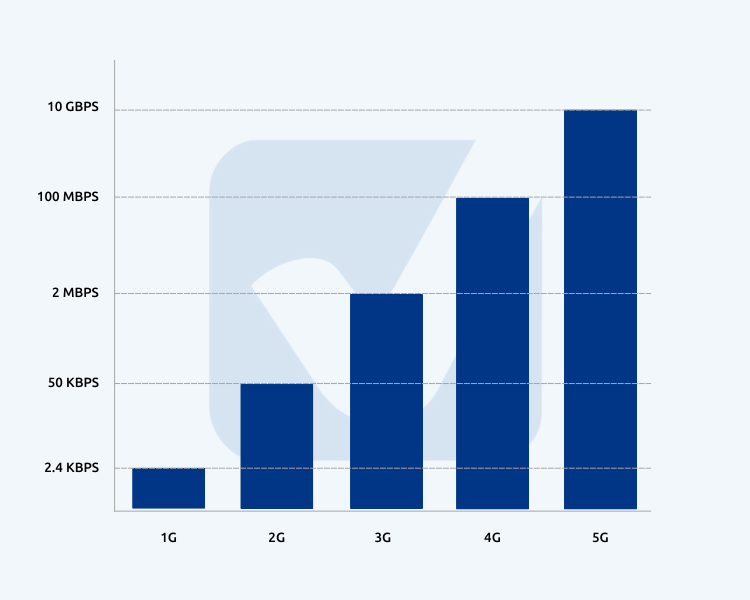5G Network: Airtel, Jio, Vi, BSNL Plans

The fifth generation of cellular networks is here! Known as 5G, it is up to 100 times faster than 4G. 5G allows people and businesses to do things they never could before. With industry-leading technology and small cell deployments on towers & in the street, we are already seeing incredible business benefits.
How 5G Can Outrank 4G? An Evolution That Leads to 5G Speeds

| . | Deployment | Technology | Latency | Multiplexing | Core Network |
|---|---|---|---|---|---|
| 1G | 1980s | Analog Voice | N/A | FDMA | PSTN |
| 2G | Early 1990s | Digital Voice | 629 ms | TDMA, CDMA | PSTN |
| 3G | Early 2000s | Mobile Data with CDMA, IP Technology | 212 ms | CDMA | Packet N/W |
| 4G | 2010s | 4G LTE, Wearable Devices | 60.98 ms | CDMA | Internet |
| 5G | Early 2018s | Higher Speeds, Superior Reliability, Wearable Devices with AI capabilities | <1ms | CDMA | Internet |
5G is designed to meet the needs of the future, including the internet of things (IoT) and autonomous vehicles. It comes with faster speeds, lower latency and less congestion across multiple industries. It is a new kind of network that can connect virtually everyone and everything – from machines and objects to devices.
In April 2019, South Korea was the first nation to adopt 5G on a large scale; followed by 88 other nations with 224 operators.
How 5G Can Outrank 4G?
The top 5 reasons why 5G is way better than 4G are:
| 5G Network | 4G Network |
|---|---|
| Expected low latency is under 5 ms. | Promising download speed to tenfold. |
| 5G will support 1Millon per km square. | 4G offers CDMA |
| 5G uses small cell technology, which means that it will offer more capacity to support more connected devices and users. | 4G transmits signals from cell towers. 4G could not meet goals it set. |
| 5G will support 1Millon per km square. | Supports 4000 devices per km square |
The first list of cities in India to receive 5G services includes: Delhi, Gurgaon, Mumbai, Bengaluru, Kolkata, Ahmedabad, Hyderabad, and Pune.
India: An Early Adopter of 5G: What is 5G Technology and How It Works?
The next generation of cellular technology (5G) takes connectivity to the next level. This technology leverages cloud technologies to provide businesses with a faster, more reliable network.
At its core are new radio signals that use wavelengths ranging from 30 to 300 GHz. These signals use millimeter waves (mmW) to send data, allowing direct connections to be made between towers, homes, and other areas. That is why it is called millimeter technology. [source: IEEE]
Delhi, Varanasi, Mumbai, and Bangalore are the cities in which Airtel has launched the 5G services and by March 2024, every Indian home will get the service as said by Airtel CEO Sunil Mittal.
With very high frequency signals,5G is capable of creating new lanes having incredible data bandwidth.
How does 5G works?
The three basic variations that compile 5G are:
Low Band: Low-band 5G frequencies are below 2 GHz and operate over long distances – up to approximately 20 miles. Low-band 5G services are expected to be used by rural areas, remote islands, and buildings that can’t get 4G coverage. These speeds could eventually enable small businesses to go global without relying on high-speed internet providers per se.
Mid-Band:5G is a mid-band spectrum that will serve as an Internet backbone for the age of the mobile internet. It is characterized by high speeds and low latency, providing a capacity layer for cities. The frequency band rates are in the hundreds of Mbps. And it’s less impacted by buildings.
High Band:5G uses higher frequencies than the current LTE standards. The frequency ranges from 24 GHz to 100 GHz, wherein, giving download speeds of 2GB per second. Because high frequencies cannot easily move through obstacles, mmWave 5G is short range by nature. Further, mmWave coverage requires more cellular infrastructure.
India: An Early Adopter of 5G
At the inaugural ceremony of Indian Mobile Congress (IMC) 2022, Prime Minister Narendra Modi launched 5G services in the country.
Jointly organized by the Department of Telecommunications and the Cellular Operators Association of India (COAI).
The conversation and plans regarding 5G network in India started in 2017. This was the time when government of India chalked out a plan to walk into 5G by 2020. The early adoption of 5G happened in a series of events:
- Telecom giants like Airtel, BSNL, Nokia, Samsung and Huawei conducted success trails in 2018
- To accelerate the fiberization and bring an insured investment in optical fiber technology, government of India formulated policies in April 2018.
- 5G- enabled mobile phones hit the market by April 2019
- Commencement of 5G spectrum auction by August 2019
- 5G trails for consumers, expected to go live by mid-2020
- 5G, launched in selected cities of India by 2022
“Apple Inc will start upgrading its iPhone models: iPhone 14, 13, 12, and iPhone SE to be compatible with 5G networks in India in December.”
5G Frequency Bands Used By Telecom
The different frequency bands available in India are 3300 MHz, 2500 MHz, 2100 MHz, 1800 MHz, 900 MHz, 800 MHz ,700 MHz and 26 GHz.
| Service Provider | Frequency Band | Total Spectrum |
|---|---|---|
| Jio | 700MHz band, 800 MHz, 1800 MHz, 3300 MHz and 26 GHz | 24,740 MHz |
| Vi | 1800 MHz, 2100 MHz, 2500 MHz, 3300 MHz and 26 GHz bands | 19,876 MHz |
| Airtel | 900 MHz, 1800 MHz, 2100 MHz, 3300 MHz and 26 GHz bands | 6,228 MHz |
Jio 5G
After the 5G services were launched on October 1, 2022, The Jio 5G network rollout began in 4 cities: Delhi, Kolkata, Chennai, and Mumbai. The initial rollout will be a pilot testing of 5G, and it is expected to take Upto 3 months to get started with other cities. Jio has adopted the standalone architecture to service cities for 5G.
Jio’s 5G Tariff Plans Jio is offering Welcome Offer to the 5G customers to enjoy the UNLIMITED DATA with speeds Upto 1Gbps. This is valid for Jio customers who are invited only and have an active prepaid or post-paid base plan of Rs, 239 or higher.
To know if you have received the Jio invitation for 5G services: Open your MyJio app to check.
Airtel 5G Plus
Airtel network has started 5G rollout in a different phase for eight cities: Delhi, Hyderabad, Bengaluru, Mumbai, Chennai, Siliguri, Nagpur and Varanasi. All the Airtel users who have 5G-enabled mobile devices would be able to use the services on their existing data plans.
Airtel’s users can check if 5G network is available for them through the Airtel Thanks App. Users will also receive a notification for if their smartphone device is compatible with 5G.
It is offering:
- Upto 30x faster downloads: You can download an HD movie withing seconds.
- 4K Videos: You can now enjoy high quality videos without buffering.
- Virtual World: You can enjoy new gaming experience: AR/VR
Vi 5G
Vi would be using 2 bands of the frequency range: 3300MHz (n78) and 26GHz (n258).
The company is planning to get started with 3300 MHz (a mid-band frequency) in 17 locations namely: Madhya Pradesh, Maharashtra, Kolkata, Karnataka, Kerala, Uttar Pradesh (East), Uttar Pradesh (West), Bihar, Delhi, Gujarat, West Bengal and Andhra Pradesh. For 26GHz, the plan is to roll out in 17 cities, which are still to be decided.
It is expected that Vi will start the rollout in 2022 and reach all the rural areas of the country by 2024. The exact rollout times are still to be revealed by the company.
Vi 5G City Delhi has become the first city to get Vi 5G
BSNL 5G
BSNL customers can use 5G network from August 15, 2023, as announced by the company. The tariff plans are expected to be affordable as much as current 4G plans.
5G: Frequently Asked Questions
What are the benefits of 5G?
5G benefits:
- Faster downloads
- Low network latency
- Flexibility with network slicing
- IoT with high density of smart devices.
What are the disadvantages of 5G?
5G disadvantages are:
- Connectivity could be impacted by the obstructions
- Initial costs for rollout are high
- It has limitations of rural access
- There is a difference between the upload and download speeds.
What are the requirements to get Airtel 5G Plus?
There are few things to be taken care of if you are moving to 5G network:
• Go to the settings tab
• Get to Connections or Mobile Network.
• Select the 5G network mode.
- Your sim should be 5G ready. Currently, all Airtel 4G sims are 5G enabled.
- Your smartphone should be 5G compatible. If yours is not; just upgrade to one that is compatible to enjoy the high speeds of internet.
- You would require to change the handset settings.
